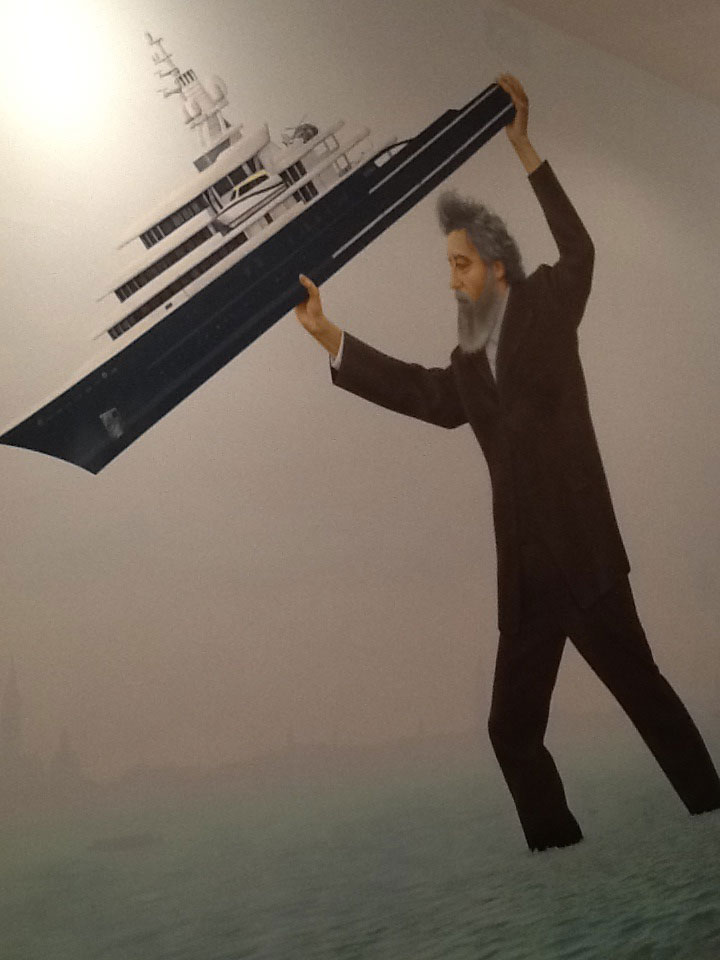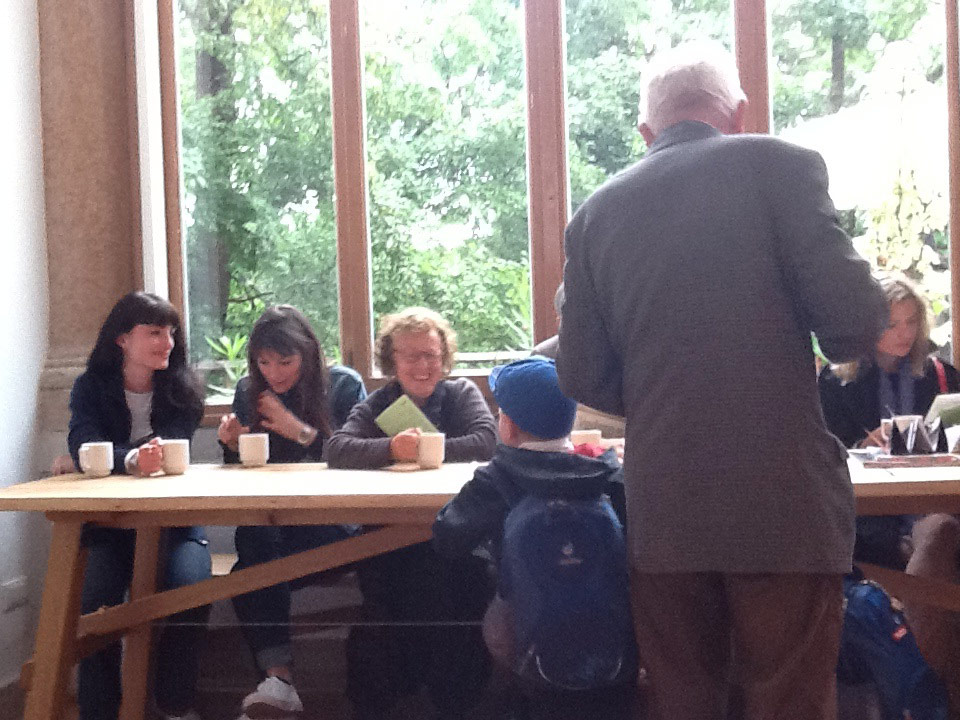Posts: Beyond
Christian Viveros-Fauné penned this succinct argument indicting the current crop of "ultra high net worth" art collectors, whose conservative interests lie less in creative experimentation than in potential ROI, and whose considerable resources are now funding the presidential campaigns of the likes of Marco Rubio and Jeb Bush. I'm not sure that laying full blame at the feet of these collectors for driving the high degree of artistic blandness he describes as being on display at Art Basel Miami is an entirely fair assessment, but much of the fault undeniably lies in the patronage structure of the art economy, and experimentation and risk-taking seem currently to be playing on the losing side.
Beyond
Nao Bustamante to lead USC Roski School of Art and Design’s MFA program
- Saturday, October 24th, 2015 | (0) Comments | Add comment >>
Performance artist with bay area roots Nao Bustamante will be helping reshape USC's MFA program starting in January 2016. Bustamante will have her work cut out for her - she joins USC in the wake of the recent defection of an entire MFA class over program promises broken. Stretcher wishes Bustamante the best of luck in her new position.
Two thought-provoking articles recently surfaced in the international press that lay bare the economics of the visual arts system. In a roundup of an unusually hectic summer market, Kenny Schachter names names and discusses deals gone wrong in a recent edition of Monopole. If you didn't already know how the gallery/collector ecosystem works, worth a read. And, a summary of a study recently completed by the Paying Artists campaign published by the Guardian found that more than 70% of artists who took part in public exhibitions last year worked for free. More attention should be paid to the economic systems in which artists (try to) work - encouraging participants at all levels to engage rather than remaining passive, or worse, complicit in economic systems that undermine artists.
After relocating to the space previously occupied by Rudolf Zwirner, the Priska Pasquer Gallery has launched its inagural exhibition showcasing artists' responses to the "new modernist" present - and speculative future - of the digital age. In the gallery's statement Pasquer poses several broad questions: "How do artists respond to the digital transformation? What themes define art in the digital age? How does the digital age change the way artists view the world? How does art work in the digital age and how can artists respond to the new challenges that present themselves?" In "Reset I", the first in a series of curatorial and artistic explorations of these themes, Pasquer draws together works by an international roster of twelve young artists, and includes an array of approaches - sound and video, 3D animation, performance, paintings, and sculptural objects. Among those works on display: in "Level Cleared", American artist Evan Roth presents a giant grid of tiny hand-dated, transparent fingerprint smears, suggesting both an ink-and-paper displacement of touchscreen interactions and the hasty, distracted repetition of biometric recognition. German artist Adrian Sauer takes the notion of the grid more literally in a series of photographs of humble graph paper. The transition of photography from a chemical to a digital, algorithmic process, subtle variations in the monotonous sameness of blank grids, and the camera's distortion of the very precision demanded by a grid all subtly reveal the lie of control and precision that digital media promises.
Priska Pasquer Gallery
September 5 - November 14, 2015
https://priskapasquer.com/?v=3a52f3c22ed6
The 55th Venice Biennial energetically shoulders through the ecologic and economic gloom hanging over the city, presenting art from a record number of nations. If one follows the intellectual route steered by Massimiliano Gioni, lead curator of the central international exhibition, the motley of competing shows even begins to make some sort of communal sense. By including historical artists (forty of the 158 artists in his exhibition, The Encyclopedic Palace, are dead) and extra-canonical art practices (including ceramic sculpture, voyeuristic photography, and "outsider" art) in his reading of "contemporary" art, Gioni recoups an emphasis on invention while sidestepping modernist notions of "progress."
Although curation of the national pavilions has little to do with the central show, the best work in the national exhibitions resonates with Gioni's undogmatic approach. For example, Britain's Jeremy Deller orchestrates photographs, murals, videos, and very welcome social practice (serving tea) into a view of Britishness that is simultaneously caustic and generous. And Tavares Strachan paradoxically manages to represent the Bahamas, with a sideswipe at colonialism, by planting his own hybrid flag at the North Pole. On the meta-political level, the turn away from didactic work seems hopeful. If there is a way past the climatalogical doom threatening humans and our biological cohort, it travels through the realm of things we don't know yet. On the artistic level, it means fresh art, not necessarily new art, but non-art-star work. The not-so-usual suspects hitting it out of the Giardini include sculptor Ron Nagle, whose suite of palm-sized, unnameable ceramic objects might just be the most sublime experience on the island.
The 55th Venice Biennial runs June 1 through November 24, 2013 at the Giardini and Arsenale in Venice, Italy.

Mural of William Morris pitching Roman Abramovich's yacht away from the Giardini, one of the components of Jeremy Deller's British Pavilion. Abramovich's is infamous for mooring his yacht at the entrance to the 54th Venice Biennial.

The "tea party" component of Jeremy Deller's installation at the British Pavilion

This is either ice from the North Pole or a clone of the original ice created by Tavares Strachan with the help of a physical chemist. Strachan no longer knows which piece is which.
The New York Times posted a concise overview of art as social practice that, though it glosses over its decades-long history, does nicely summarize the deep (perhaps irreconcilable) divide between the market and its institutions on one hand, and social practitioners on the other. Stretcher has covered many such projects over the years - some more and some less successful - and has chatted with some of the field's most important theorists. As institutions struggle to keep up with - and reframe for conventional display - these projects, however, they're still asking the same, stale questions.
From the editors
Authors from Posts
- Allegra Fortunati
- Amar Chaudhary
- amy berk
- Asha Schechter
- Aude de Bourbon
- Berin Golonu
- Charles Linder
- Cheryl Meeker
- Dale Hoyt
- David Lawrence
- Diana Gaston
- Ed Osborn
- Elise Barclay
- Ella Delaney
- Glen Helfand
- Gloria Tanchelev
- Happy D
- Jeannine McDonald
- Julie Deamer
- Mark Van Proyen
- Megan Wilson
- Meredith Tromble
- Natalie Welch
- Terri Cohn
- Tucker Nichols
Archived Posts
- December, 2015
- October, 2015
- September, 2015
- July, 2013
- May, 2013
- April, 2013
- March, 2013
- August, 2012
- June, 2012
- March, 2012
- February, 2012
- January, 2012
- December, 2011
- October, 2011
- September, 2011
- July, 2011
- April, 2011
- March, 2011
- February, 2011
- January, 2011
- December, 2010
- November, 2010
- October, 2010
- September, 2010
- August, 2010
- July, 2010
- June, 2010
- April, 2010
- March, 2010
- February, 2010
- January, 2010
- December, 2009
- November, 2009
- October, 2009
- September, 2009
- August, 2009
- July, 2009
- June, 2009
- May, 2009
- April, 2009
- February, 2009
- January, 2009
- December, 2008
- November, 2008
- October, 2008
- September, 2008
- August, 2008
- July, 2008
- June, 2008
- May, 2008
- April, 2008
- March, 2008
- February, 2008
- December, 2007
- November, 2007
- October, 2007
- September, 2007
- August, 2007
- June, 2007
- May, 2007
- April, 2007
- March, 2007
- February, 2007
- January, 2007
- December, 2006
- November, 2006
- October, 2006
- September, 2006
- August, 2006
- July, 2006
- June, 2006
- May, 2006
- April, 2006
- March, 2006
- February, 2006
- January, 2006
- December, 2005
- November, 2005
- October, 2005
- September, 2005
- August, 2005
- July, 2005
- June, 2005
- May, 2005
- March, 2005
- February, 2005
- January, 2005
- December, 2004
- November, 2004
- October, 2004
- September, 2004
- August, 2004
- July, 2004
- June, 2004
- May, 2004
- April, 2004
- March, 2004
- February, 2004
- January, 2004
- December, 2003
- November, 2003
- October, 2003
- September, 2003
- August, 2003
- July, 2003
- June, 2003
- May, 2003
- April, 2003
- March, 2003
- February, 2003
- January, 2003
- December, 2002
- November, 2002
- October, 2002
- September, 2002
- August, 2002
- July, 2002
- June, 2002
- May, 2002
- April, 2002
- March, 2002
- February, 2002
- January, 2002
- December, 2001
- November, 2001
- October, 2001
